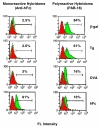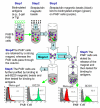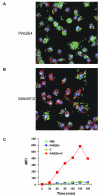Properties and function of polyreactive antibodies and polyreactive antigen-binding B cells
- PMID: 17888628
- PMCID: PMC2100422
- DOI: 10.1016/j.jaut.2007.07.015
Properties and function of polyreactive antibodies and polyreactive antigen-binding B cells
Abstract
The advent of hybridoma technology has made it possible to study in-depth individual antibody molecules. These studies have revealed a number of surprises that have and are continuing to change our view of the immune system. None of these was more surprising than the demonstration that many antibody molecules are polyreactive - that is they can bind to a variety of different and structurally unrelated self- and non-self-foreign antigens. These findings make it clear that self-reactivity is a common and not necessarily forbidden or pathogenic feature of the immune system and that the well-known broad antibacterial activity of natural antibodies is largely due to polyreactive antibodies. In this brief review we will discuss these insights and their impact on basic and clinical immunology.
Figures









Similar articles
-
Polyreactive Antibodies: Function and Quantification.J Infect Dis. 2015 Jul 15;212 Suppl 1(Suppl 1):S42-6. doi: 10.1093/infdis/jiu512. J Infect Dis. 2015. PMID: 26116731 Free PMC article. Review.
-
CD5+ B lymphocytes, polyreactive antibodies and the human B-cell repertoire.Immunol Today. 1989 Nov;10(11):364-8. doi: 10.1016/0167-5699(89)90268-5. Immunol Today. 1989. PMID: 2482031 Review.
-
Antibody polyreactivity in health and disease: statu variabilis.J Immunol. 2013 Aug 1;191(3):993-9. doi: 10.4049/jimmunol.1300880. J Immunol. 2013. PMID: 23873158 Review.
-
Polyreactive antigen-binding B (PAB-) cells are widely distributed and the PAB population consists of both B-1+ and B-1- phenotypes.Clin Exp Immunol. 2004 Jul;137(1):88-100. doi: 10.1111/j.1365-2249.2004.02511.x. Clin Exp Immunol. 2004. PMID: 15196248 Free PMC article.
-
Antigen-binding B cells and polyreactive antibodies.Eur J Immunol. 1995 Feb;25(2):579-86. doi: 10.1002/eji.1830250241. Eur J Immunol. 1995. PMID: 7533091
Cited by
-
Autoimmune Diseases: Enzymatic cross Recognition and Hydrolysis of H2B Histone, Myelin Basic Protein, and DNA by IgGs against These Antigens.Int J Mol Sci. 2022 Jul 22;23(15):8102. doi: 10.3390/ijms23158102. Int J Mol Sci. 2022. PMID: 35897678 Free PMC article.
-
Impaired CD27+IgD+ B Cells With Altered Gene Signature in Rheumatoid Arthritis.Front Immunol. 2018 Mar 23;9:626. doi: 10.3389/fimmu.2018.00626. eCollection 2018. Front Immunol. 2018. PMID: 29628928 Free PMC article.
-
IgM in microbial infections: taken for granted?Immunol Lett. 2009 Aug 15;125(2):79-85. doi: 10.1016/j.imlet.2009.06.003. Epub 2009 Jun 17. Immunol Lett. 2009. PMID: 19539648 Free PMC article. Review.
-
Covalent binding antibodies suppress advanced glycation: on the innate tier of adaptive immunity.Acta Naturae. 2009 Jul;1(2):66-72. Acta Naturae. 2009. PMID: 22649604 Free PMC article.
-
Hexon modification to improve the activity of oncolytic adenovirus vectors against neoplastic and stromal cells in pancreatic cancer.PLoS One. 2015 Feb 18;10(2):e0117254. doi: 10.1371/journal.pone.0117254. eCollection 2015. PLoS One. 2015. PMID: 25692292 Free PMC article.
References
-
- Haspel MV, Onodera T, Prabhakar BS, Horita M, Suzuki H, Notkins AL. Virus-induced autoimmunity: monoclonal antibodies that react with endocrine tissues. Science. 1983;220:304–306. - PubMed
-
- Haspel MV, Onodera T, Prabhakar BS, McClintock PR, Essani K, Ray UR, et al. Multiple organ-reactive monoclonal autoantibodies. Nature. 1983;304:73–76. - PubMed
-
- Satoh J, Prabhakar BS, Haspel MV, Ginsberg-Fellner F, Notkins AL. Human monoclonal autoantibodies that react with multiple endocrine organs. N Engl J Med. 1983;309:217–220. - PubMed
-
- Prabhakar BS, Saegusa J, Onodera T, Notkins AL. Lymphocytes capable of making monoclonal autoantibodies that react with multiple organs are a common feature of the normal B cell repertoire. J Immunol. 1984;133:2815–2817. - PubMed
-
- Casali P, Notkins AL. Probing the human B-cell repertoire with EBV: polyreactive antibodies and CD5+ B lymphocytes. Annu Rev Immunol. 1989;7:513–535. - PubMed
Publication types
MeSH terms
Substances
Grants and funding
LinkOut - more resources
Full Text Sources
Other Literature Sources

